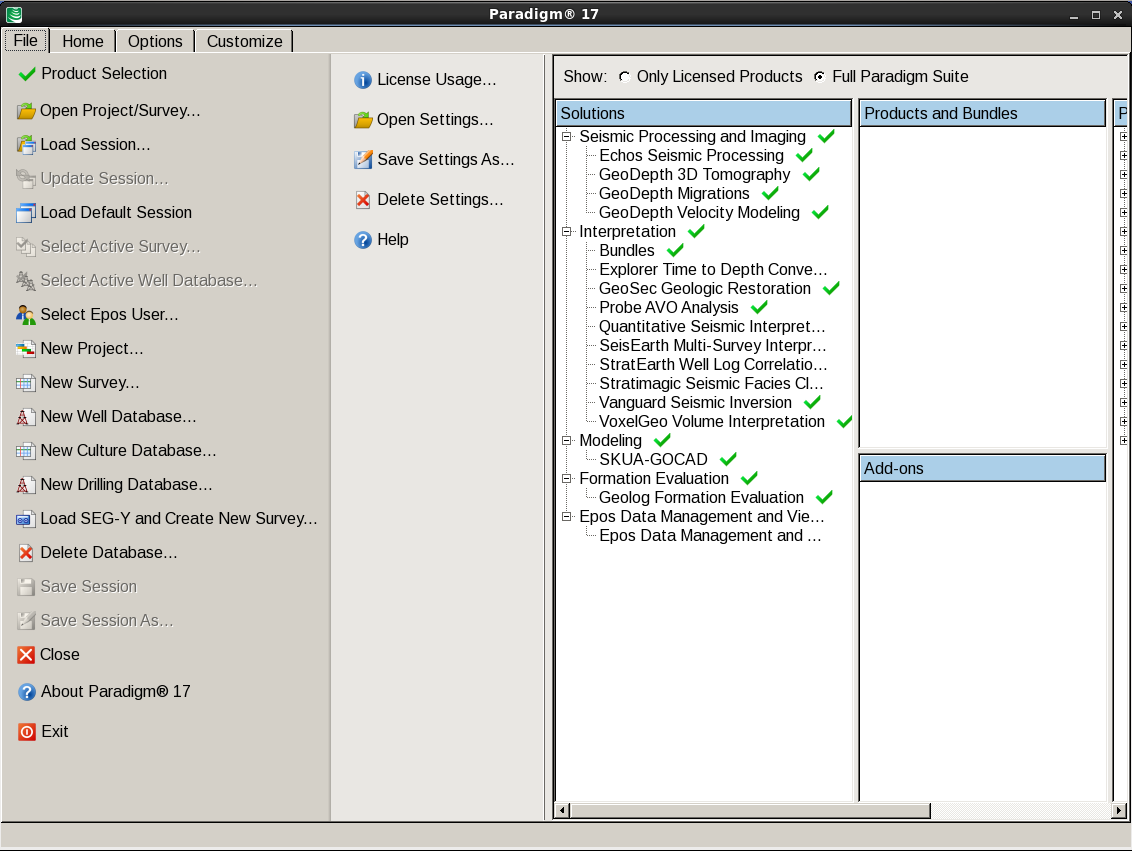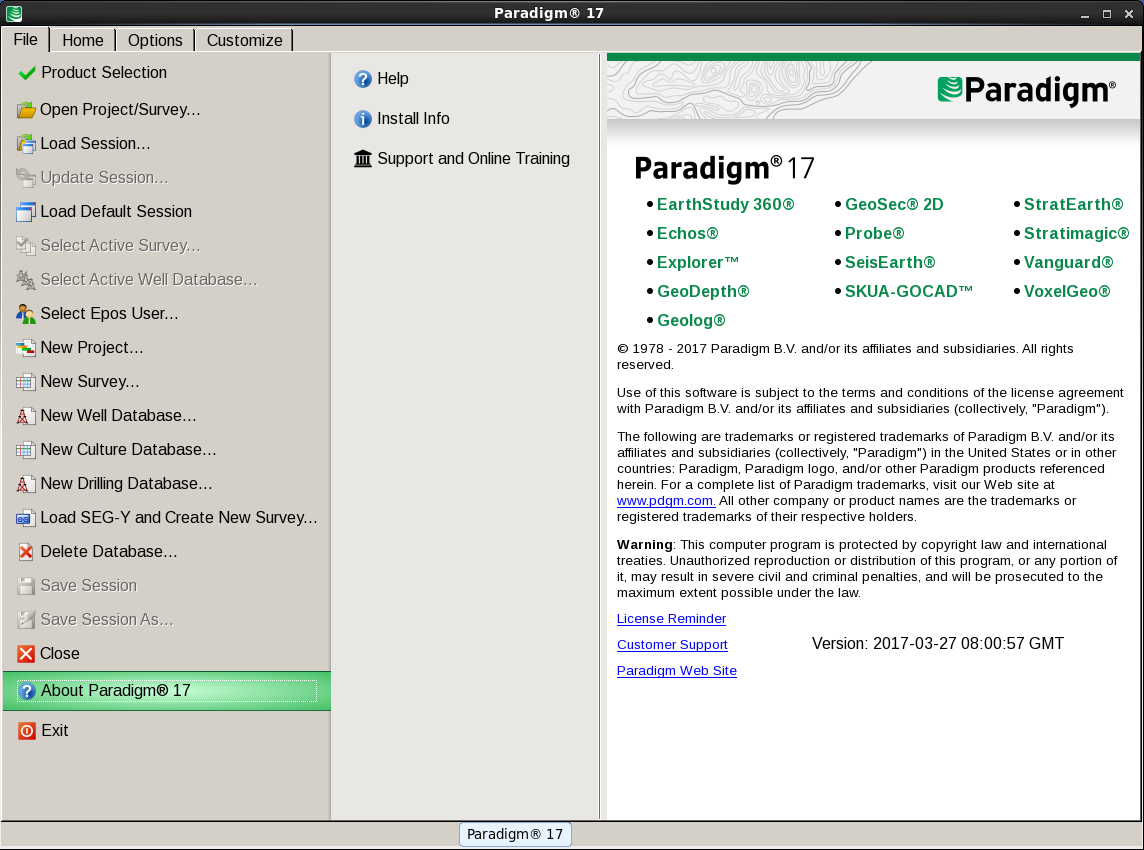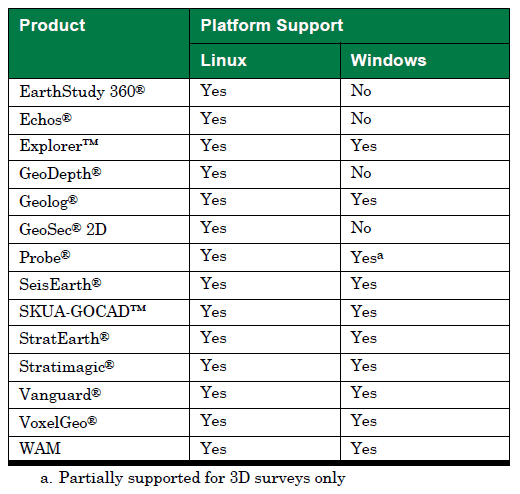We are pleased to announce the availability of the ParadigmВ® 17 software release. Paradigm 17 extends the highdefinition
software platform offered in previous releases, and adds new features, advanced integration, and
extended interconnectivity.
The following products are included in Paradigm 17:
вҖў EarthStudy 360В® – Full-Azimuth Imaging and Characterization
вҖў EchosВ® – Seismic Processing
вҖў Explorerв„ў – Time-to-Depth Conversion
вҖў GeoDepthВ® – Velocity Modeling and Imaging
вҖў GeologВ® – Formation Evaluation
вҖў GeoSecВ® 2D – 2D Geological Structural Restoration
вҖў QSI (ProbeВ®/VanguardВ®) – AVO Analysis, Seismic Inversion, and Property Determination
вҖў SeisEarthВ® – Multi-Survey Interpretation
вҖў SKUA-GOCADв„ў – High-Definition Earth Modeling
вҖў StratEarthВ® – Geologic interpretation
вҖў StratimagicВ® – Seismic Facies Classification
вҖў SysdrillВ® Designer – Embedded Well Planning
вҖў VoxelGeoВ® – Voxel-Volume Interpretation
вҖў WAM – Web Asset Manager
The release is designed to improve the effectiveness of asset teams and enable superior decision-making using all available data in integrated workflows. To achieve this goal, Paradigm 17 introduces application and infrastructure enhancements to its SeisEarth interpretation system, consolidating its core interpretation windows (3D Canvas,BaseMap, and Section) into a single application. This integration is incorporated in part, or in full, into manyParadigm products and bundles that share the same windows. The result is improved cross-product integration, shorter work time and fewer button clicks. Waveform classification based on the well-established Stratimagic Neural Network approach is also now part of SeisEarth, as is a new Machine Learning-based, rock-type classification plug-in for interpreters. The new rock-type classification uses seismic data and facies logs to predictfacies volumes and their probability of occurrence, to improve reservoir characterization in conventional andunconventional plays.
In other enhancements to our Interpretation solution suite, VoxelGeo now offers significantly improved performance with multi-volume GPU rendering, and a new volume fusion tool. In SeisEarth, a built-in technique for loading image files enables the use of scanned and published cross-sections and seismic.
The Paradigm Quantitative Seismic Interpretation (QSI) solution is now available to WindowsВ® users, enabling them to enjoy the same advanced technology as LinuxВ® users. Significant enhancements have been made to theВ crossplot utility as well as to wedge/2D forward modeling, to enable more effective workflows and a betterВ understanding of the seismic response. This release also offers new workflows to extract more information from
inversion results.
GeoDepth users will enjoy productivity improvements when conducting multi-line 2D projects, including a new,generic GUI to define and run any supported application on all 2D lines in a project/survey, and a new clusterbasedВ parallelization engine that easily runs hundreds of 2D jobs simultaneously. This release offers full new 2DВ grid tomography and imaging workflows, and a 2D Kirchhoff time migration based on 3D running on multi-2D lines.В Enhancements to the GeoDepth 3D structural model-based tomography have been made to support geologicallyconstrainedВ velocity models and strengthen integration between GeoDepth and SKUA.
For our EarthStudy 360 full-azimuth decomposition and imaging solution, enhancements to the imaging operatorВ and filters to separate specular and diffraction energy have been introduced to generate improved and higherВ quality diffraction images from the fully recorded wavefield.
Other new features for Processing and Imaging users include a new method in Echos for production-orientedВ estimation and application of effective Q from seismic data, to support imaging in highly dispersive regimes andВ workflows with broadband acquisition and processing. New capabilities in refraction statics, data regularization,and trace interpolation have also been introduced to strengthen these widely used capabilities.
The SKUA-GOCAD Subsurface Modeling solution includes a number of important new features and performanceВ improvements. Robust structural models can now be constructed for even more complex geological conditions. Significant effort has gone into the further development of reservoir geomechanics. This includes new tools forВ building geomechanical mesh and directly exporting structured and unstructured grids to Dassault SystГЁmesВ Abaqus, along with the relevant mechanical rock properties and pore pressures. It is now easier than ever toВ customize workflows with macros, for enhanced automation and greater user empowerment. We have alsoВ improved connectivity and data exchange with the Epos data repository and with Petrel. In addition to the filebasedВ RESQML data exchange, SKUA-GOCAD can now connect to Petrel through a direct live link.
In Formation Evaluation, Geolog 8 in Paradigm 17 offers innovative new petrophysics features, including MonteВ Carlo uncertainty analysis for our probabilistic petrophysical solution Multimin, and a new 3D petrophysics featureВ that enhances the analysis of high angle and horizontal wells. The release also includes a new processing methodВ for slowness frequency analysis of full waveform sonic logs. Geolog 8 offers improved geomechanics, productionВ logging, and casing inspection functionality, along with new technologies for cement evaluation, pulsed neutron,В and DTS/DAS handling. Direct access to Matlabв„ў code using Geolog Loglan enables existing research work andВ custom calculations to be easily delivered to end users. And connectivity options have been expanded to includeВ completion import from Peloton WellViewВ®, and an update of Geolog-Petrel connectivity to Petrel 2016.
In addition to expanded communication between SKUA and Epos and the Petrel Connector, we have improved seismic data and ASCII import/export, and developed a new interface for batch loading data from OpenWorks® and GeoFrame®. Paradigm 17 supports the latest Linux and Windows 64-bit operating systems: Red Hat® Enterprise Linux 6.5 and subsequent minor releases, and 7.0 and subsequent minor releases, and Windows 7, 8.1,and 10.
Paradigm product development is carried out in collaboration with our customers, with the main goal of enhancingВ the user experience and outcomes. In Paradigm 17, as in other recent releases, Paradigm has significantlyВ expanded its investment in quality assurance, including extensive internal and beta testing. This, together with theВ technical depth of our solutions, is aimed at providing you with the best technologies for safe, reliable, and profitable extraction of the earth’s minerals. Your success is our highest priority. We encourage you to explore theВ many new features of Paradigm 17, and we look forward to your continued suggestions for improving our productВ lines.



